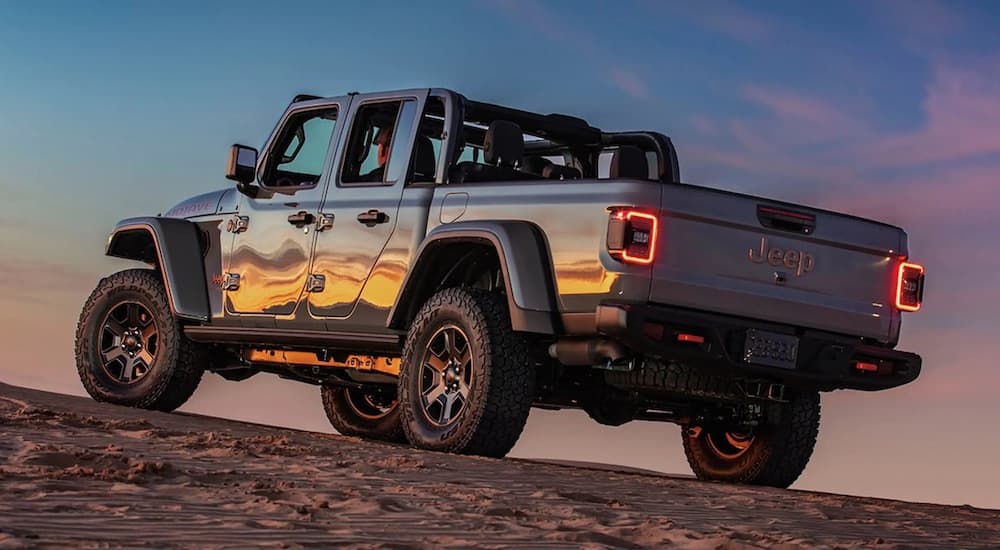The 2023 Jeep Gladiator has consistently been ranked best in its class regarding payload, towing capacity (gas), torque (diesel), and ground clearance. Anyone who test-drives a Gladiator is guaranteed to be impressed, as it is one of the most remarkable vehicles—of any type—on the market today.
Due to its success, the Gladiator has a loyal fanbase that eagerly checks out the specs of each year’s model, happy to see how it’s developed, and—crucial for Jeep—excited to buy a new one. The Gladiator’s stellar performance has allowed it to be a steady seller since it returned to the market with its long-awaited 2020 model. Its qualities are not the only reason the Gladiator sells so well, however; its name itself has power, and that name traces its origins to the 1960s.

Wait—Did You Say the 1960s?
Yeah, man; it’s in the title of the article. While the Gladiator name returned with its 2020 model, the original Gladiator had come about long before that. The Jeep Gladiator first appeared in 1963 as a full-size pickup truck. Its structure was similar to that of the Jeep Wagoneer—except, instead of being crafted to ferry around people, this Gladiator aimed to carry a payload for labor purposes. It existed as a utilitarian version of the Wagoneer, but its name gave it an extra sense of heft.
The term Gladiator had a tendency to stick in the mind. Was its name given an extra bump since the film Spartacus had just come out to record-breaking numbers? Maybe! Fate can be funny like that. Either way, the name became part of the culture, and the Gladiator made its mark.
How Does the Retired Gladiator Compare to the 2023 Model?
At first glance, they may as well be from entirely different worlds. The Gladiator of the ’60s was a skinnier vehicle, not as imposing as the current Gladiator; given that it was designed for labor, not style, the Gladiator of the ’60s had a more austere look, yet it still impressed in its own way. With its small cabin and a large bed, the original Gladiator forms the image of the classical pickup truck, more so than even the famed Chevy C/K lineup of the same era.
The 1960s Gladiator also saw military use—and not just by the US military, either, making an appearance in the Lebanese Civil War. However, its main purpose was always civilian use. Plenty of trucks had seen action in World War II; in the aftermath, more appeared on the roads of the United States—and the Gladiator was among them. While still useful for military purposes, the average citizen had grown to desire a pickup at home. With it, they could get some serious work done as some versions of the Gladiator could carry about 1,500 lbs—an amount that outdoes some pickup trucks available today. (The current Gladiator still has it beat with a capacity of 1,710 lbs.)
The Gladiator had a large impact on American working life. Laborers could now expand their working zone. Picture this: if you’re someone who sells heavy material, getting it from location to location can be difficult. If you have a high-quality pickup truck, that becomes easier, which means you can now please a larger market.
The Modern Gladiator
If the Gladiator of the 1960s was austere, the 2023 Jeep Gladiator can only be described as its polar opposite. Stylish and sleek while still intimidating, the 2023 Jeep Gladiator is ready to get dirty and have a good time. This Jeep craves adventure—for you, your family, and your friends. That’s not to say it can’t live the working life of the original Gladiator, but that’s not the 2023 model’s main focus: this one wants to go outbacking.
It’s far happier in the dirt than on the road. It has 11.6 inches of clearance, so it can cover terrain no matter how treacherous, and its electronic locking differentials allow it to traverse some serious rock. This beauty can handle water, too; thanks to special water sealing, the Jeep can tackle up to 31.5 inches of water. Tough to think of many other recreational vehicles that can handle almost three feet of water, but creeks and streams are not a problem for this Jeep.
Thanks to its stellar capability, the new Gladiator has become the first pickup truck ever to become Trail Rated—and then it topped its own achievement by also getting Desert Rated. This adventurous, recreational pickup is a far leap from the original.
Connections to the Gladiators of Yore
The Gladiator of old and the Gladiator of now are still Jeeps in design, structure, and dependability. There’s a reason Jeep has not gone the way of other manufacturers that have faded over the years. They make vehicles that their drivers can depend upon, and they have thus accumulated an incredibly loyal fanbase. While all car manufacturers have dedicated customers, Jeep fans are often exceptionally serious about their fandom; there’s a reason the slogan “It’s a Jeep thing” has come about for Jeep and Jeep only.
Another similarity is in, of all things, their differences. The original Gladiator expanded the average person’s ability to use a pickup truck for labor; the current Jeep Gladiator has expanded what the average person can do when trekking into the wilderness or the desert. While the original aimed for utility and the current one for adventure, both wanted to push their respective market into new territory, letting other manufacturers rush to catch up. Breaking new ground has long been a goal of the Gladiator, no matter its intended purpose.
Then, of course, there’s the fact that they share a name.
What’s In a Name?
The similarities between the original Gladiator and the new one aren’t in name only, but, as you’ve seen, it’s not wildly far from the truth to claim that. So why, then, do they share a name?
Well, the Chevy Camaro doesn’t look much like the Camaros of old, either, but they still have the same name. Heck, compare the Honda Civic that first debuted in the 1970s to how it looks now—wildly different—and, in this case, the Civic didn’t even “return” to the market; there’s been a new model each year since ’72. No car, even one continually made, remains the same, so the fact that the original Gladiator and the 2023 model are far different beasts is not that odd.
Still, why not go with a new name? It had been decades since the Gladiator was on the road.
Because names have power, especially with automobiles. Model names conjure a vibe as much as they conjure a purpose. While the 2023 Gladiator aims to be more for pleasure than work, it still contains the same exciting energy of 1960s Gladiators—a feeling that you’re in a truck that’s a step ahead of every other one.
That’s why the name sticks around. That’s why owners like bragging about owning a Gladiator. The 2023 model is pushing the limits, just as its forefather did in the 1960s. Forty years from now, there may be a new type of Gladiator. (Maybe a spaceship!) It may not have much in common with the 2023 model, but it will share a message that new ground is being broken.
Automakers keep driver psychology in mind whenever debuting a new vehicle. They know that the urge to own a piece of automobile history has a hold on many consumers. So long as that desire remains, you can expect plenty of other manufacturers to return to classic names so drivers can feel just a bit like time travelers.




